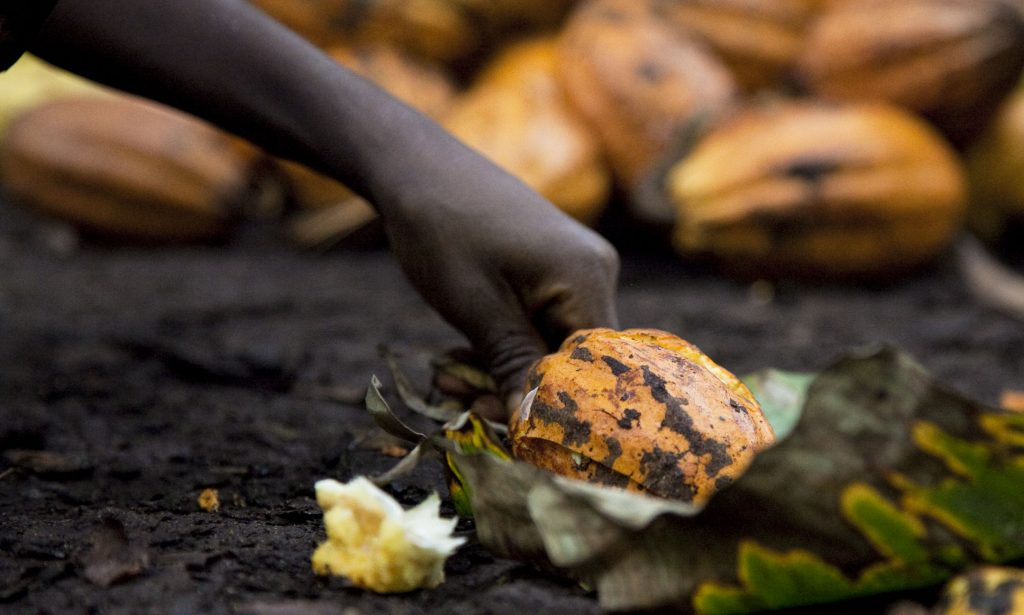
Mani was only 13 years old when her older brother went missing. Her parents and family friends recall searching for her brother, Robin, for 2 months before they gave up their search. Mani remembers going to school and always mistaking boys in her brother’s class for Robin – she recalls that her “heart would skip a beat just to become disappointed again.” Three years later, around 2 a.m., Mani was kidnapped from her home. Trapped in a vehicle for hours, she was then untied, and her blindfold was removed. Mani was pushed into a metal cage with dozens of other children. She and the children around her were wailing in panic. Mani felt like she was about to suffocate.
Mani’s story is just one of the millions of children kidnapped and enslaved on cocoa farms along the Ivory Coast. In Mani’s case, the “headhunters” that kidnapped her had also kidnapped her older brother years before. Mani’s kidnappers threatened her parents to stay silent, or they would have taken both children the night her brother was taken. Mani’s parents broke their agreement with the kidnappers and filed a police report. They later discovered that the police in the nearby station were bribed and partners with the headhunters. Corrupt officers would receive nearly $5,000 for every missing child report they discarded. After the police report, the headhunters were tipped off by their comrades and made a point to come back three years later and kidnap Mani as well. Leaving her parents heartbroken and childless.
This story is not unique. An estimated 2 million child laborers still work in the chocolate industry to harvest the cocoa beans. Child slavery was proven to still be utilized by large, popular chocolate companies such as Nestlé, Hershey, Cargill, ADM, and Barry Callebaut. The conditions children are kept in have been called “the most inhumane living situations humans have experienced since old-world slavery” by UNICEF. Children are often kept in crowded, metal cages. Many of them are chained by their hands and feet in order to ensure they remain captive through the night.
Harvesting cocoa beans is a labor-intensive process. It requires a person agile enough to climb the delicate branches of cocoa trees to locate the ripe cacao beans at the top. For this reason, children’s small frames make them prime targets for headhunters. This harvesting process usually involves children between the ages of 12-17 wielding razor-sharp, foot-long machetes. These machetes are necessary to cut ripe beans from the trees, and child laborers are often instructed to climb trees with these dangerous tools stuck between their teeth, so their hands are free to climb. This dangerous endeavor often ends with these children losing fingers or entire hands.
After hearing stories such as the one above, many wonder—why has this not stopped? The answer is American consumerism.
American customers make up nearly 80% of Hershey’s yearly sales. Nestle CEO, Ulf Schenider, spoke about how American culture is the most “chocolate friendly culture” in the world. Schnider detailed how the “American calendar” goes from Halloween to Thanksgiving to Christmas to Valentine’s Day, creating a “goldmine for most chocolate companies around the world.”
With overpowering demand and astronomically profitable margins due to cheap labor, chocolate companies found no reason to stop these inhumane practices. Due to this, international human rights organizations stepped in and declared that “the big 6 chocolate companies” needed to sign a “Declaration Against the Use of Child Slaves” in 2011 in which they pledged to stop using child laborers within the next year.
It’s 2020, and rather than a decrease, there has been a 7% increase in child slavery use by chocolate companies. Companies such as Nestlé opt to pay the fines imposed on them for breaking the declaration they signed rather than lose the profit margin they get from using virtually free labor. While horribly cruel, this reasoning makes sense. 20 million dollar fines are a drop in the bucket for big bulge chocolate companies that have nearly monopolized the world’s market.
What can be done?
As consumers, we can truly make a difference in this situation. Small swaps in our shopping patterns can change the lives of millions. While it seems like a daunting task, consumer boycotts have helped in the past. In 2011, American consumers boycotted tuna. There was a massive campaign that drew awareness to the fact that tuna fishing was contributing to the extinction of blue-fin dolphins since they were getting caught in the tuna nets. Large tuna companies saw a “22% decrease in sales in the coming months due to the “Blue-Fin Boycott.” By the end of the fiscal year, most tuna companies had invested and pledged to use “dolphin-friendly nets.” Similarly, five years ago, a “Boycott Cadbury” campaign launched in France which spurred Cadbury to pledge only to sell fair trade products in France.
If we as consumers make a point to hit chocolate companies where it hurts this holiday season, we can make an impact on the conditions of the children that harvest their cocoa beans. While this boycott is daunting, it would only cost a consumer $20 extra in one holiday season to make a switch to fair trade chocolate and consume mindfully. As humans, we have a responsibility to help children like Mani and her brother. No child or family deserves to live in fear for their lives so we can enjoy chocolate on the holidays.
